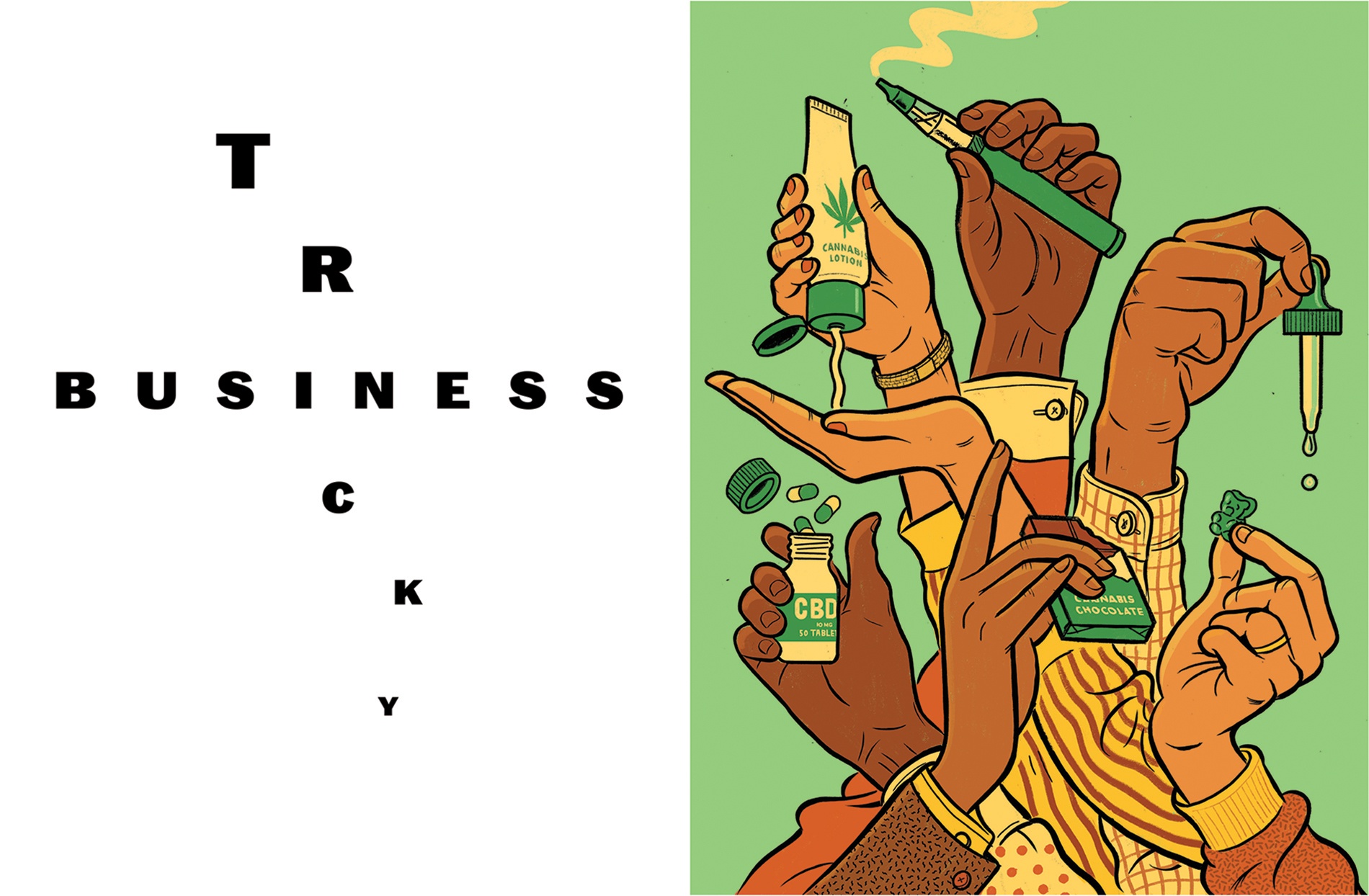
With a quarter of the U.S. population now living in states where marijuana is legal, the U.S. is entering a weed boom. The nascent industry creates products that millions of consumers want, that some doctors swear by—and that the federal government still outlaws. Opponents say that’s for good reason.
Not too long ago, a flashy trade show off the Vegas strip would have been the last place you’d have expected to find Crystal Mustric Keesey ’93. A self-described “plant person,” she realized after graduating with degrees in East Asian studies and art history that she wanted to go in a different direction.
“I wanted a career where I would earn most of my income outdoors,” she says.
Keesey moved to California and became a botanist and by 2001 had started a small environmental consulting business helping farmers get the regulatory approvals needed to develop agricultural land. And when California voted in 2016 to legalize recreational marijuana, she found herself facing an unexpected new opportunity.
Flooded with demands from people who needed help with land and water use permits for legal cannabis farms, she saw the industry was poised to grow. And that’s how, with work well under way for the 16-acre cannabis farm she and her partner are now developing, Keesey found herself in Las Vegas checking out everything from laboratory equipment and plant nutrients to packaging machinery at MJBizCon—a giant marijuana industry conference—just days before Thanksgiving.
“If someone had told you 25 years ago that there’s this company called Google—knowing what you know now, would you want to get in on the ground floor?” Keesey asks. “It’s incredible to see the explosion of this industry. It’s a big business now.”
That it certainly is—and a whole lot more. The normalization of marijuana as an everyday medicine and consumer product also marks a legal and health care revolution, and, ultimately, a change in cultural attitudes that mirrors the shift in views towards alcohol following the repeal of the 18th Amendment. When Colorado became the first state to legalize the recreational use of marijuana in 2014, “people were kind of holding their breath, waiting to see if the sky would fall,” says Brian Muraresku ’02, the founding executive director of Doctors for Cannabis Regulation, which supports legalization. And when it did not, he adds, “people began to question the whole idea of [marijuana] prohibition.”
In the five short years since, legal weed has only gained momentum. Michigan voters approved recreational use in November, joining Washington D.C. and nine other states—Alaska, California, Colorado, Maine, Massachusetts, Nevada, Oregon, Vermont, and Washington—in permitting anyone over 21 to use cannabis. Medical marijuana also got a boost at the polls in Utah and Missouri, bringing to 33 the states that allow doctors and pharmacists to advise patients on cannabis for a host of ailments. And in many of the states that allow medical marijuana, private use by adults has effectively been decriminalized. While still technically illegal, police in many cases have reduced the pursuit of low-level marijuana offenses.
About 25 percent of the country’s population now lives in states where adult use is fully legal—a number likely to grow. Newly elected governors in Connecticut and Illinois campaigned on plans to permit recreational use, and in December, New York governor Andrew Cuomo also said that he would push for it aggressively. New Jersey is moving in the same direction, and with nearby Massachusetts opening its first recreational pot stores in November, Rhode Island governor Gina Raimondo proposed moving from medical marijuana to full-on legalization in her 2020 budget plan, released January 17.
Rapid transformation
The rapid shift has surprised even many who work in the industry. Four years ago, Jake Heimark ’11 co-founded Plus Products, whose marijuana-infused
gummies are among the top-selling “edibles” in California. In late 2017, his team mapped out a timeline for how they expected the market to develop. “Things we thought would be happening two and a half years from now have already happened,” he says. “The speed with which things are happening just seems to be coming out of nowhere.”
“There is a big population of people who are open-minded about cannabis, but want nothing to do with traditional ‘stoner’ culture.”
Yet for all that, the industry is in its infancy—and faces plenty of challenges. The biggest, of course, comes from the federal government, which sees no medical value in marijuana and treats its use as a crime. Federal restrictions still classify cannabis as a “Schedule 1” drug as dangerous as heroin, hindering health research and restricting business development.
Moreover, plenty of opponents remain who believe the rush to legalization is misguided, particularly given concerns about use by teens and young adults. A recent book by a former New York Times reporter has also raised concerns about possible links between marijuana and mental illness. “There is much more that is not known about marijuana than is known,” says Michael Cerullo ’64, who came to Brown as a freshman in 1960 and is now a Rhode Island–based psychotherapist and founder of What’s the Rush, RI? Before allowing kids to, as he puts it, “play Russian roulette with their brains,” he argues more study is needed.
Now, as more states consider legalization, both advocates and opponents are looking closely at the experience of the states who moved first. And one thing they agree on: the debate’s not going away. If anything, it’s intensifying, because today’s seemingly sudden momentum has been a long time coming. In part, it’s generational: 62 percent of the country now supports legalization, twice the share in 2000. Many have been or know casual users of marijuana themselves; they see it as no different than a beer or a cocktail at the end of day. With little evidence that it is a gateway to harder drugs, people no longer believe the dire warnings of the Reefer Madness era.
“There is a big population of people who are open-minded about cannabis, but want nothing to do with the traditional ‘stoner’ culture that’s long surrounded it,” says Bettina Huang ’06, who in 2018 launched Say Hi, a discovery site for design-oriented paraphernalia, edibles, and wellness products, several years after developing the idea while completing her MBA. “It’s the target audience of every consumer goods company, and they are the future of cannabis.”
Changing culture
The growing number of people who now turn to medical marijuana for relief from such ailments as pain, nausea, and PTSD has also helped normalize its use—and sparked pressure to ease restrictions on medical research to determine where else it might help. There’s increasing recognition that criminalization has disproportionately hurt poor communities and people of color. African Americans are nearly four times as likely to be arrested for marijuana than whites, though both use at roughly the same rates, according to a 2013 study by the ACLU.
Advocates say one of the biggest reasons to support legalization is the simplest. Marijuana is less addictive and causes fewer health problems than tobacco or alcohol, so the public health concerns used to justify its ban are unfounded. That those other substances are legal while marijuana is criminalized “illustrates that we have a broken regulatory system,” says Leo Beletsky ’04 MPH, an associate professor in law and health sciences at Northeastern University. “Whatever it is trying to do from a public health standpoint, it’s not accomplishing.”
That doesn’t mean there aren’t public health concerns. But much of the debate over legalization centers on whether they can best be addressed through a continued ban or with a regulated system that would encompass public education and controls that are difficult to enforce on the black market.
“The overarching worry is that making cannabis more accessible for adults will trickle down into greater use by teens,” says Jeffrey Hunt, a professor and program director of the Child and Adolescent Psychiatry Fellowship at the Alpert Medical School.

So far, however, there’s little evidence that legalization is leading more teens to toke up. While some national studies showed slight rises earlier in the decade, the Colorado Department of Public Safety published an extensive report on its experience in October that registered little change. Roughly 19 percent of high schoolers reported using marijuana the prior month—a figure stable since 2005, and no higher than the rest of the country. Data published last fall by Washington’s State Department of Social and Health Services showed the same trend, while an August study commissioned by California’s Department of Health Care Services found that teenage marijuana use actually declined from 2015 to 2017, as legalization advanced.
Hunt cautions, though, that the data is preliminary, and it could be years before a clear picture emerges. In the meantime, much is still unknown about the impact of cannabis on teenage brain development. Using marijuana can cause a drop in cognitive and executive functions that can last several days; if kids smoke on the weekend, their thinking may still be affected on Thursday. For those who smoke only occasionally—and this goes for adults, too—he says that’s not likely much of a problem. “But if you start smoking in tenth grade and use pretty regularly, there is a cognitive delay or decline that could happen,” Hunt says. “And we don’t know for sure—does everyone return to full normality?”
Serious concerns
One fear is that the active ingredients in marijuana—THC, the psychoactive element, and cannabidiol, or CBD, which is touted for pain relief and other applications—could interfere with the normal “wiring up” of the brain that occurs well into the mid-20s for males, and early 20s for females. “If you use a lot early on, the question is whether that could change the wiring of your brain,” he adds.
Despite those questions, Hunt says he’s changed his own position on legalization. Once an opponent, he now thinks regulation would be more effective. “Our current approach isn’t working,” he says. “Teens are still smoking too much, and we don’t have resources to monitor it, because it’s all on the black market.” Instead, he argues, closely-regulated legalization combined with taxation, as with alcohol and tobacco, would allow for better treatment strategies and education campaigns aimed at curbing teen use—and, importantly, provide the funding to put them in place.
He and others say one critical area where more research is needed concerns the high potency of today’s pot, which has elevated levels of THC compared to weed available 15 or 20 years ago.
One recent study by Hayley Treloar Padovano, an assistant professor of psychiatry and human behavior at Brown’s Center for Alcohol and Addiction, and co-authors from the universities of Iowa and Michigan, found that people who start out using higher potency marijuana appear to more quickly develop cannabis use disorder, which can disrupt users’ ability to cut back or meet obligations. So far, states have put few regulations in place to define what THC level is “safe.” Such policies might be helpful in minimizing the risks of high-potency pot.
Greater public education would also help when it comes to pregnant women and marijuana, says Elizabeth Aston, an assistant professor of behavioral and social sciences at Brown’s School of Public Health. She cites a recent Colorado study in which researchers posing as pregnant women with morning sickness contacted 400 marijuana stores; more than two-thirds recommended the women quell symptoms with marijuana. But that has potentially dangerous long-term consequences, Aston warns. Some studies have linked low birth weight to maternal marijuana smoking, and there may be psychological impacts to the child such as high impulsivity and learning disorders as well.
Aston’s research touches on another of the thorniest issues cited by Cerullo and others opposed to legalization: Will the easy availability of pot lead to more traffic accidents? Various studies have shown that marijuana use by drivers can slow reaction times and impair judgment and motor coordination, yet firm conclusions are hard to draw. While two meta-analyses completed in 2011 showed that the risk of a fatal car crash nearly doubled with marijuana use, a more recent study comparing Washington and Colorado to eight states where cannabis remained illegal found no difference in fatality rates.
As for DUIs, the October study by Colorado’s Division of Criminal Justice found that the percentage of all DUIs that involved marijuana use rose slightly, from 12 percent in 2014 to 15 percent in 2017. State officials warned, however, that it’s too early to read much into that bump, which may simply reflect increased enforcement.
“Black market stuff is scary: Everyone has a story of a roommate in college who ate a brownie and didn’t get off the couch for two days
Despite the measurement difficulties, Aston says one thing is certain: Many marijuana users are driving when they shouldn’t be. In a survey she conducted of habitual marijuana smokers, the majority not only reported driving after lighting up; many also drive while they’re smoking. “A lot of marijuana users think they’re better drivers after using marijuana,” she says. “They may be more cautious, but they are more likely to get into an accident or make a mistake.” Here, too, Aston argues, stronger public education campaigns could be developed to create the broader awareness needed to change behavior, much like what has been done to discourage drinking and driving.
Profit motive
Whatever else the impact, legalizing marijuana has created a booming new industry. In 2013—the year before Colorado and Washington first allowed sales of recreational marijuana—nationwide sales of medical marijuana ran an estimated $1.3 billion. For 2018, legal sales for medical and recreational use combined was expected to hit $10.5 billion, according to Arcview Market Research and BDS Analytics. By 2022, they estimate the U.S. market will more than double, to $22.2 billion. And, of course, the U.S. is not alone. In October, Canada became the first country to fully legalize cannabis nationwide. Arcview and BDS estimates sales there will grow nearly five-fold, to $5.9 billion, by 2022.
“We don’t know fully the extent of the business possibilities,” says Scott Moskol ’89, a partner in the cannabis practice at Boston law firm Burns & Levinson—one of the first firms in the country to create such a specialization. “But it is here and will be a huge industry.”
There’s more than private money to be made in legal weed. For local authorities, too, it promises a boon. Colorado’s revenues from marijuana taxes and fees have quadrupled in four years, to nearly $270 million in 2018, while Washington pocketed $319 million in fiscal 2017—55 percent more than it got from taxes and fees on alcohol. And although a sluggish start to California’s legal market left tax revenues well below early estimates, the state still took in $234 million through the first three-quarters of the year.
That big pot of money is attracting corporate attention. The parent companies behind brewers Modelo, Molson, and Coors have invested in the industry—meaning weed beer could one day be on tap. The Coca-Cola Company is considering “wellness drinks” laced with CBD—the non-psychoactive ingredient in marijuana that is used as a sleep aid and pain reliever. Pharmaceutical giants including Merck and Pfizer want in on the action; they are among the biggest filers of patents for cannabis-related products in Canada. And when it comes to Big Tobacco, the Marlboro Man could soon become the Marijuana Man. Altria, Marlboro’s parent company, paid $1.8 billion for a 45 percent stake in the Cronos Group, a Canadian cannabis company, while Imperial Brands, the maker of Kool and Winston, has invested in a small medical marijuana startup.
That’s a prospect that has opponents like Cerullo worried. He warns it’s inevitable tobacco companies will try to hook young people on marijuana products, just as they did with cigarettes. “They have to do it to guarantee a base to build their business on,” he says. “It took us 35 years to get the tobacco industry under control, and we’re starting this industry without learning any of the lessons from that experience.”
Yet it isn’t just big business that’s eyeing the new market; the potential is also drawing entrepreneurs like Plus Products’s Heimark, whose unlikely path began with a post-graduation job doing payments at Facebook. He moved to Denver to start an auditing firm just as legalization got underway. When several clients needed help with regulatory compliance, he realized—much like Keesey in California—that the business was on a roll, and focused on the potential of the small but fast-growing market for edibles. “There are a lot of people who’ve been trained their whole life not to smoke,” he says. “And black market stuff is scary: Everyone has a story of a roommate in college who ate a brownie and didn’t get off the couch for two days.” By carefully controlling the precise dose of THC and CBD in each gummy, he adds, “we’ve made it a lot safer.”

He returned to California to develop the manufacturing processes needed to ensure consistent quality and launched Plus. Thanks to its sophisticated packaging and flavors like Cranberry Shortbread and Blackberry & Lemon, its gummies are top sellers in California and Heimark is exploring expansion to other states.
Complex regulations
Cannabis may be experiencing a boom, but it is not an easy business. The federal restrictions mean companies can only legally sell cannabis products in the state they’re made, for example, so Heimark will have to set up separate “micro” manufacturing sites to expand to Colorado, Massachusetts, or other states. Regulations around sales, packaging, and distribution are also heavy—and frequently changing. In California, Keesey complains that the regulations concerning child-proof packaging have changed three times, “and we’re still waiting for the final draft.” She and other investors are reluctant to invest heavily until they know what the rules ultimately will be, a key reason—along with high taxes—why California’s legal market has taken off much more slowly than anticipated. “The regulatory hoops you have to go through are so narrow, it’s like threading needles,” says Keesey.
Then there are the myriad issues for patients and consumers that the complex new market is creating. Jesse Stout ’06, a longtime activist who helped enact Rhode Island’s medical marijuana law while a student at Brown, points out that people who have purchased marijuana legally can’t bring products from one state to another. And some states, including California, where he now practices law, allow local communities to opt out and ban commercial cannabis activities. “Some people live 100-plus miles from a cannabis store, even though it’s supposedly legal,” he says.
Moreover, the federal restrictions mean many banks won’t risk dealing with cannabis companies, so transactions must be done with cash or convoluted work-arounds. Nor will the Federal Patent Office consider granting patents to the industry, even as considerable investment is going into creating new products and the technologies needed to develop the industry.
“We’re witnessing the birth of a legal industry, one which has lived underground for almost a century,” says Patrick Rea ’98, who runs a Colorado-based incubator program to train entrepreneurs entering the cannabis business. While some are developing marijuana-based products directly, many others are creating services such as payroll processing or in-store sales data tracking, since the traditional suppliers of such services to mainstream companies refuse to work with the cannabis industry. “When you go from an illicit to a legal market, operators need the basics,” he adds.
Indeed, firms like Heimark’s that want to raise funds by going public can’t even turn to Wall Street; instead, they list on the Canadian stock market. “We have to hold our board meetings in Canada to make sure one of our directors doesn’t get banned from the U.S. for life,” he says.
When might that change? Few expect federal policy to loosen significantly during the Trump Administration. Former attorney general Jeff Sessions was strongly against it, though he never followed through with the crackdown many feared. The administration appears unlikely to change policies, though William Barr, the new U.S. Attorney General, has eased the rhetoric somewhat. During his Senate confirmation hearings, he said he wouldn’t use federal enforcement to go after marijuana companies that are operating legally in their home states. But he also made clear that he personally opposes ending the federal prohibition on marijuana.
Still, most see an evolution happening in the not too distant future—an idea even Barr hinted at, telling the senators that “the current situation is untenable.” That’s a view shared by FDA chief Scott Gottlieb, who recently said it’s inevitable federal policy will have to be reconsidered “at some point soon.” Most in the industry believe any major reworking of federal laws will be taken up by President Trump’s successor as more states shift—particularly if there is momentum from big states outside of the Northeast or the West Coast, such as Texas, Florida, Ohio, or Pennsylvania. But however long it takes, given the money plowing into the industry and the change in public opinion, advocates have little doubt that day will come.
“It’s only a matter of time,” says Beletsky of Northeastern. “This is a genie that’s not going back into the bottle.”
Jane Sasseen is the executive director of the McGraw Center for Business Journalism at the Craig Newmark Graduate School of Journalism at the City University of New York.





